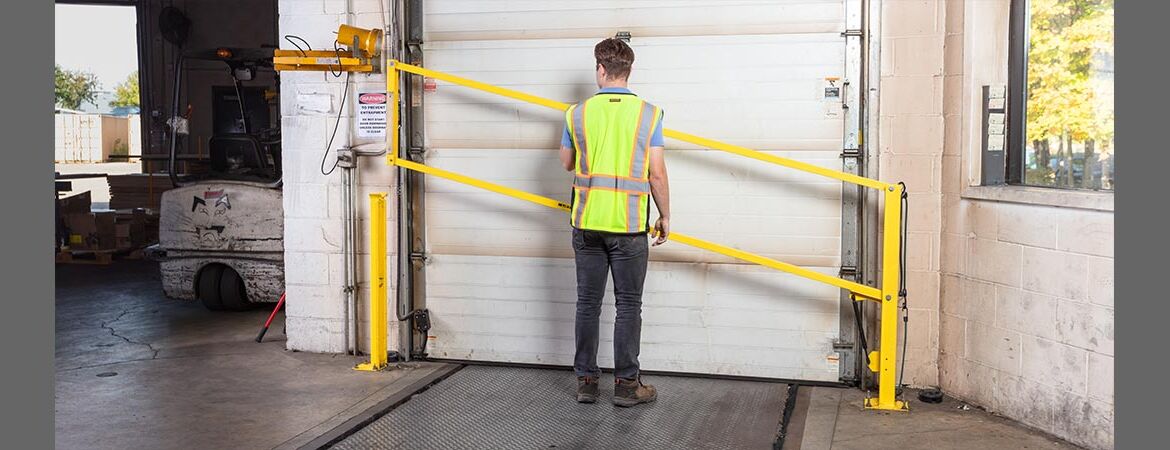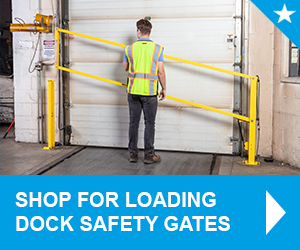
With increased emphasis on hyper-local distribution facilities, loading dock safety has risen in importance. In fact, it’s begun receiving greater scrutiny from OSHA safety inspectors since the early 2020s.
Leading fall protection manufacturers have responded in kind, continually meeting distribution center needs for OSHA compliant gates that improve safety and can even help streamline somewhat hectic workflows. Just when warehouse and distribution center activities increase, so too does the risk of injury.
We’ll cover how facility owners and safety managers can maximize both safety and productivity at loading docks for last-mile distribution centers, without compromising on efficiency.
Establishing a Culture of Safety
Above all, safety managers must avoid making assumptions (which, in this industry, means assumption of liability). Always take stock of the prevailing OSHA, CCOHS, or other local compliance requirements affecting your region. This is always the first step in verifying a given fall protection device meets your precise safety compliance needs.
One such assumption is that fall protection is not a concern at ground level operations; however, fall protection relates to both workers falling from height and falling objects. Another mistake is focusing all your attention on loading docks, or even assuming loading docks don’t present a fall hazard if they’re under the 4-foot (1.2 m) threshold for general industry (as in OSHA 1910.28[b][1][i]).
Fall Risks: More Than Just Working at Height
While any ledge or walking-working surface over 4 feet attracts greater scrutiny by regulators, it’s far from the only fall risk. Loading dock fall hazards also include slips and trips from numerous sources, including:
- Oil and machine fluids
- Ambient conditions, such as water, ice, and condensate
- Extension cords and other cables
- Dust and powdery materials
- Slick floors and/or improper footwear
- Walking-working surface damage (including cracks, holes, and overall wear and tear)
- Uneven surfaces, such loading docks and truck trailers of incompatible heights
- Rushing and all-around poor workflow management
- Poor lighting where surface types change
Communicating Loading Dock Safety Hazards
These and other surface condition hazards exemplify the need for effective hazard communication, itself is a major compliance requirement. The right fall protection equipment becomes even more effective with site-wide notices targeting the most unsafe loading dock practices, such as:
- “Dock jumping,” even with low ledges
- Leaving clutter or wheeled equipment near docks for any length of time
- Proper material handling, lifting, and stacking
- Driving forklifts and other powered equipment too fast and neglecting “tail swing” – only authorized personnel should be entrusted with operation of forklifts and other industrial vehicles
- Taking extra precaution with uneven surfaces
It’s also important to encourage reporting any equipment malfunction, loose handrails, uneven surfaces, and other signs of disrepair. By teaching your workforce proper hazard recognition and safety procedures – along with using OSHA compliant gates and other equipment – you’ll tremendously reduce compliance trouble. More importantly, you’ll secure far fewer loading dock injuries for years to come.
Keeping up With Greater Workflow Dependencies
Loading docks for last-mile facilities present more falling object hazards than most other warehouse/distribution environments, due to greater volumes of incoming and outgoing shipments. These loads are often extremely heavy, weighing upwards of a ton or more, and there’s a greater tendency to stack items due to more costly real estate near city limits.
There’s also much more site activity, as last-mile loading docks must facilitate faster turnarounds. For these reasons and more, safety and facility managers share a heightened responsibility to ensure:
- Loading bay ledges are clearly visible, using brightly colored edges
- Good facility-wide ventilation, especially with running vehicles (per OSHA 1910.178[c][2][iv])
- Clear identification of hazards, including:
Effective compliance and operations also depend on orderly workflows, particularly where industrial vehicles and manual laborers cross paths. As we’ll discuss further below, more innovative loading dock safety gate and modular railing systems can transform a disorderly loading bay into a pinnacle of safety and efficiency.
Meeting Procedural Concerns with Effective Safety Equipment
Greater shipment frequency increases the need for more robust and user-friendly loading dock safety equipment. The right loading dock safety gate can not only meet strict regulatory scrutiny but improve efficiency.
Loading dock safety bears a significant impact on workflow. It’s important any fall protection barriers don’t create additional hazards despite resolving their primary function. That’s often the case for horizontal loading gates, which protrude into work areas and can even swing unpredictably as workers handle heavy loads.
Maximizing Loading Dock Safety and Space Efficiency
A vertical-lift loading dock safety gate eliminates the drawbacks of standard gates, empowering workers to control access to the loading bay while also preserving maneuvering room. Because some loading docks have low clearance, innovative fall protection manufacturers have developed dual-lift vertical gates that halve clearance height requirements.
Adaptable Fall Protection for Unconventional Spaces
Modular guardrails are also becoming an industry staple, due to their versatility with quickly swappable connector posts. Distribution centers and loading docks are particularly fluid work environments, where fixed permanent railing has an immense bearing on long-term workflow – it essentially makes workflow dependent on railing position.
It should be the opposite. Modular railing systems are built to install in minutes and support an almost limitless number of loading dock scenarios, including:
- Protection for long, continuous outdoor loading docks
- Movable mezzanines, where fast hand-tool installation supports easy integration with adjacent areas and mezzanine gates
- Separation of unique work zones that may change over time, such as for authorized personnel and industrial vehicles
- Machine guarding, catwalks, and other applications where guardrails must interface with modular safety gates
In the latter case, how do you meet safety gate needs with limited space, such as small stair platforms (see figure D-7 of OSHA 1910.25, for example)? Last-mile distribution centers are unique for their typically more compact layouts, which can create more confined space issues.
Vertical lift gates for personnel and small-width vehicles (within 6 ft, or 1.8 m) are the perfect solution for any location where access control conflicts with limited space requirements. As with the loading bay example above, vertical-lift OSHA compliant gates provide equally effective fall protection, when closed, without crowding workers when open.
Loading Dock Safety and Efficiency: Never at Odds Again
Maintaining smooth, timely operations is essential for last-mile facilities. Yet that doesn’t have to mean lax safety practices – in fact, it should mean the opposite.
The most innovative fall protection manufacturers understand that greater safety often carries a need for greater efficiency, as well. Fabenco is proud of our role meeting the widest range of fall protection needs for warehousing and distribution centers, with OSHA compliant gates and railing systems that expand functionality as your facility grows.
For any questions about our advanced loading dock safety gate and guardrail systems, contact us, and request a quote today.





